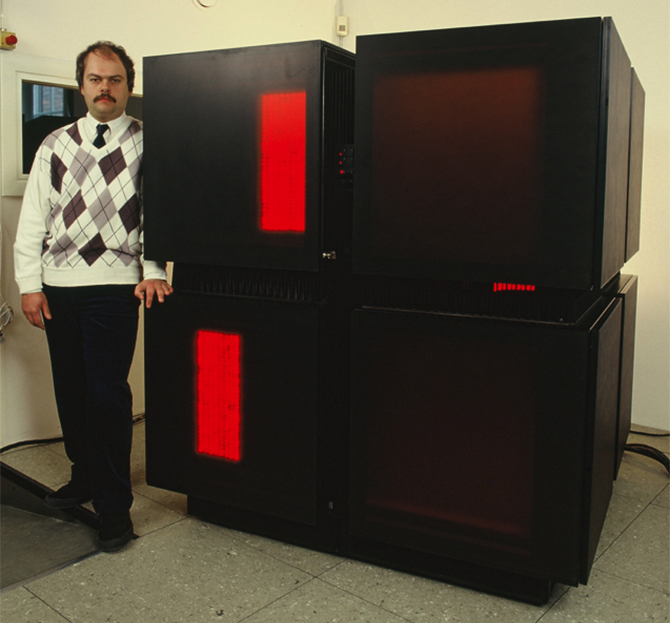How PDC began
In 1988, a group of researchers at the School of Computer Science and Engineering at the KTH Royal Institute of Technology (KTH) in Stockholm applied for a grant to buy a massively parallel computer: a CM-2 Connection Machine from Thinking Machines Corporation (TMC). A driving force behind the application was the belief that massively parallel computers would become an important technology, both in computer science and high-performance computing. Equally importantly, there was a need for the performance that could be delivered by this type of computer architecture, particularly in terms of extending the scope of modelling that would be possible. The grant was awarded, and a price and configuration for the system were negotiated. During the autumn of 1989, TMC installed an 8K Connection Machine CM-2 at KTH.
At this time, the idea came up to group together resources and activities around the CM-2 and already existing parallel computers at KTH. As a result, a centre was established at KTH. In Swedish it was called the “Parallelldatorcentrum” (PDC), which means “Centre for Parallel Computers”. PDC was inaugurated by Janne Carlsson, the President of KTH at the time, on the 15th of January 1990. PDC was established to be a focal point and national forum for research on the development of parallel computers and for using such systems for research purposes in various fields. PDC’s activities during its first years were centred around the Connection Machine. In January 1991, PDC applied for an upgrade of the CM-2 to a CM-200. The application was successful and the upgrade was installed in December 1991.

An important milestone for PDC was the installation of the IBM SP2 cluster (named Strindberg) in 1994. The Strindberg SP2 supercomputer consisted of multiple nodes interconnected by a switch. (A switch in this context is a device that makes it possible to transfer information efficiently between many nodes.) The Strindberg system was significant because it demonstrated that supercomputers could be built by connecting many powerful workstations (nodes). This approach is still the dominant method for designing HPC systems due to the cost benefits resulting from the (relatively cheap) mass production of the individual nodes.
At that stage, Sweden had lagged behind other industrialised countries in the utilisation of supercomputers for many years. The Swedish Council for High Performance Computing (HPDR) was formed in July 1994 to rectify this situation. In early 1995, after careful evaluation by the HPDR and an international team of experts, the HPDR decided to locate the majority of the HPC activity at PDC. In mid-1995, KTH and the HPDR signed a contract describing the services that PDC would provide. PDC was awarded a grant to take on the responsibility as the leading high-performance computing centre serving the Swedish academic community. As well as as providing supercomputing resources, PDC also regarded educating researchers and supporting them in using HPC for their research as an important part of the PDC mandate.
The HPDR funding made it possible to substantially upgrade the Strindberg SP2 system and the capacity was more than doubled in early 1996. The number of nodes was increased from 55 to 96, and the existing nodes were upgraded with faster processors and more memory, and the amount of disk storage space was increased. That put the system at 64th position in the June 1996 Top500 list . Later in 1996, Strindberg was upgraded again to have 110 nodes (giving a peak performance of 29 gigaflops) and 20 GB of memory.
During October 1996 PDC was evaluated by a committee appointed by the HPDR to provide recommendations upon which the HPDR could base a decision regarding future funding for PDC. The criteria being evaluated were the service level of PDC, user satisfaction, the hardware and software configurations, and the plans for the future of PDC. After a thorough examination, the committee presented a report which stated that the PDC system had reached, and in some cases exceeded, the level that could be expected from a national HPC facility. A user survey provided by the HPDR showed that many users regarded PDC as an enabling factor in their research. This very positive report and the following decision by HPDR led to funding being provided for PDC in the coming three years, and, on the 1st of March 1997, PDC was inaugurated as the national facility for high-performance computing by the Mayor of Stockholm, Mats Hulth.
Since then, the supercomputer systems at PDC have continued to be upgraded to provide top-notch HPC systems for research, thanks to KTH and the Swedish organisations that provide funding for the Swedish HPC research infrastructure, such as the current National Academic Infrastructure for Supercomputing in Sweden (NAISS) and previously the Swedish National Infrastructure for Computing (SNIC) and HPDR.
Details about many of the earlier systems at PDC can be found here and you can see how they performed compared to other systems in the Highlights of PDC’s TOP500 entries . (The TOP500 list is published twice a year and lists the 500 most powerful public computer systems in the world.) If you are curious about the names of PDC systems, you can read about the artists who inspired the names .
If you are interested in how research on the HPC systems at PDC has developed since PDC was established, you can read the early PDC reports and the subsequent PDC newsletters online.
